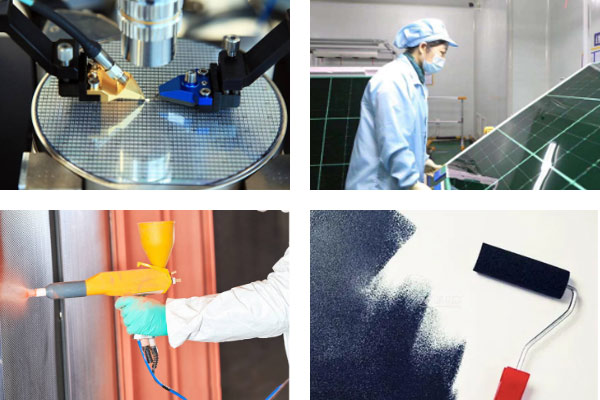Dissolving power
The following substances are freely soluble in Butoxyl:
rosin, glycerol resin esters, mastic, chlorinated rubber, cellulose ethers (ethyl and benzyl cellulose), nitric acid esters of cellulose (nitrocellulose, celluloid), butyric acid esters of cellulose (cellulose acetate butyrate), polystyrene (coatings), vinyl chloride/vinyl isobutyl ether copolymers, vinyl chloride/vinyl acetate copolymers, vinyl chloride/vinyl propionate copolymers, polyvinyl ethyl ethers, polyvinyl butyral, highly acetalized, polyvinyl acetate, methacrylates, aromatic-formaldehyde resins, ketone resins, phenol-formaldehyde resin, rosin-modified phenolic resins, carbamic acid ester resins, urea-formaldehyde resins, melamine resins, alkyd resins, Soft Resin KTN, chlorodiphenyl resins, epoxy resins, chlorinated polypropylene, heavy machine oil, linseed oil, linseed-stand oil, castor oil, wood oil, spindle oil, ®Genomoll 100 (dioc-tylphthalate), triscresyl phthalate (TCP), tris-2-chloroethyl phos-phate and phthalic acid polyglycol esters. Coumarone resins, poly-vinyl chloride (post-chlorinated) and waxes are freely soluble only if heated.
The following substances are sparingly soluble:
bitumes, coal-tar pitch, acaroid resin, unplasticized resols; natural rubber, acetic acid esters of cellulose (acetyl cellulose) and polyvinyl chloride (PVC) may swell in Butoxyl.
The following substances are insoluble dammar, shellac, neoprene, poly-isobutylene, polyvinyl butyral, low degree of acetalization, polyvinyl alcohol, polyvinyl carbazoles, polyethylene, polypropylene grades, polytrifluoromono-chloroethylene, polytetrafluoro-ethylene, polyamides, poly-terephthalic acid glycol ester, polyacrylonitrile and polyacetals.

Applications
Because of its faint odour and excellent dilutability with ethanol and hydrocarbons, Butoxyl is highly suitable for brush-applied paints. It prevents the familiar blushing or milky opalescence of the drying paint films caused by thinners even when used in fairly large amounts.
Butoxyl in combination with ethanol does not attack rubber and can therefore also be used for paints applied by machine (rubber rollers).
An addition of Butoxyl gives spray paints a smooth surface and high gloss even when ester resins and oxidatively curing resins are used.
Because of its low volatility it is best added to spray paints in amounts of no more than 5 – 10 %. Butoxyl brings great advantages when used in stoving enamels because of its low volatility, promoting flow and gloss of the paint films.
Butoxyl can be used as a solvent in isocyanate- and epoxy-containing systems.
In high-solids paints Butoxyl can be employed as a solvent to lower the viscosity.
Sales specifications | ||
Appearance clear liquid (visual examination) | clear liquid | |
| 3-Methoxy-1-butyl acetate (DIN 51405) | % (w/w) | min. 98.5 |
| 3-Methoxy-1-butanol (DIN 51405) | % (w/w) | max. 1.0 |
| Acid value (DIN EN ISO 3682 / ASTM D 1613) | mg KOH/ | max. 0.05 |
| Water (DIN 51 777, part 1) | mg/kg | max. 300 |
| Residue on evaporation (DIN 53 172) | mg / 100 ml | max. 2.0 |
| Density at 20 °C (DIN 51 757, method D) | g/cm3 | 0.954 – 0.956 |
| Platinum-Cobalt-Color (DIN ISO 6271) | Pt-Co units | max. 10 |
The product is constantly monitored to ensure that it adheres to the specified values
| Technical data | ||
| Boiling range at 1013 hPa (DIN 53 171) | °C | 169 – 173 |
| Refractive index nD at 20 °C (DIN 51 423, part 2) | 1.408 – 1.410 | |
| Evaporation number (DIN 53 170, diethyl ether = 1) | 75 | |
| Vapour pressure at 20 °C | mbar | 1.5 |
| Melting temperature | °C | – 80 |
| Viscosity at 20 °C (DIN 51 562) | mPa · s | 1.43 |
| Specific heat at 20 °C | kJ/kg · K | 1.93 |
| Heat of vaporization at 1013 hPa | J/g | 318.4 |
| Dielectric constant at 20 °C | 8.0 | |
| Specific electrical conductivity at 20 °C | S · cm–1 | app. 0.8 · 10–8 |
| Water absorption at 20 °C | % (w/w) | 4 |
| Solubility in water at 20 °C | g/l | 30 |
The technical data are used solely to describe the product and are not subject to constant monitoring.
In high concentrations Butoxyl can also cause narcotic effects.
Splashes on the skin or in the eyes should be washed away with plenty of water (if necessary call a doctor). If the product is swal-lowed, a doctor must be called at once. Clothing splashed with the product must be changed immediately.
The very mild odour of Butoxyl should in no way mislead users into failing to observe the general safety precautions.
As with practically all solvents, precautions such as the use of skin creams are advisable.
Provision should be made for good room ventilation and fresh air. Inhalation of the vapours should be avoided. Vessels con-taining Butoxyl should if possible be kept closed. Contact with the skin and mucous membranes should be avoided.
In the event of fire, the following extinguishing agents can be used:
water spray jet, foam, carbon dioxide and dry powders. Foam has to be applied in large quantities because some of it is destroyed. Containers at risk must be cooled with water.
Measures must be taken during transfer and filling of the product to prevent the build-up of an electrostatic charge.
For safe disposal in accordance with the regulations Butoxyl has to be taken to an authorized disposal site (e. g. incineration plant).
Small quantities that have been spilt or have leaked out must be taken up with an absorbent mater-ial and disposed of in accordance with the regulations.
Dispatch and storage | |
| Storage category (VCI) | 3B |
| GGVE/RID | non-regulated |
| GGVS/ADR | non-regulated |
| ADNR | Container-Ship: non-regulated Tanker: Cl. 8 |
| IMDG code | non-regulated |
| UN number | - |
| IATA-DGR | non-regulated |
Butoxyl is supplied in road tankers, rail tank wagons and standard drums.
Butoxyl should be stored in a cool dark place and prevented from coming into contact with air and water. Butoxyl maybe stable in storage unter these conditions.